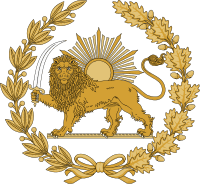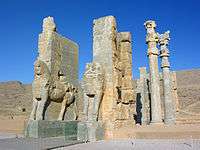Afsharid dynasty
| Afsharid dynasty | ||||||||||||||||||
| افشاریان Afsharian | ||||||||||||||||||
| ||||||||||||||||||
| ||||||||||||||||||
 | ||||||||||||||||||
| Capital | Mashhad | |||||||||||||||||
| Languages | Persian (official language; court language; civil & fiscal administration) [3][4] Turkic (military administration)[5] | |||||||||||||||||
| Government | Absolute Monarchy | |||||||||||||||||
| Shahanshah | ||||||||||||||||||
| • | 1736–1747 | Nader Shah | ||||||||||||||||
| • | 1747–1748 | Adil Shah | ||||||||||||||||
| • | 1748 | Ebrahim Afshar | ||||||||||||||||
| • | 1748–1796 | Shahrukh Afshar | ||||||||||||||||
| History | ||||||||||||||||||
| • | Established | 22 January 1736 | ||||||||||||||||
| • | Disestablished | 1796 | ||||||||||||||||
| Area | 4,500,000 km² (1,737,460 sq mi) | |||||||||||||||||
| Currency | toman[6] | |||||||||||||||||
| ||||||||||||||||||
| Today part of | | |||||||||||||||||
The Afsharids (Persian: افشاریان) were members of an Iranian dynasty which originated from the Turkic Afshar tribe in Iran's north-eastern province of Khorasan, ruling Persia in the mid-eighteenth century. The dynasty was founded in 1736 by the brilliant military commander Nader Shah, who deposed the last member of the Safavid dynasty and proclaimed himself Shah of Iran. During Nader's reign, Iran reached its greatest extent since the Sassanid Empire, and at its height it controlled modern day Iran, Armenia, Georgia, Azerbaijan, most of the North Caucasus (Dagestan, Kabardino-Balkaria, and parts of modern-day Chechnya), Afghanistan, Bahrain, Turkmenistan, Uzbekistan, and Pakistan, and parts of Iraq, Turkey, North India, and Oman. After his death, most of his empire was divided between the Zands, Durranis, Georgians, and the Caucasian khanates, while Afsharid rule was confined to a small local state in Khorasan. Finally, the Afsharid dynasty was overthrown by Mohammad Khan Qajar in 1796, who would establish a new native Iranian empire and restore Iranian suzerainty over several of the aforementioned regions.
The dynasty was named after the Turcoman Afshar tribe from Khorasan in north-east Iran to which Nader belonged.[7] The Afshars had originally migrated from Turkestan to Azerbaijan in the 13th century. In the early 17th century, Shah Abbas the Great moved many Afshars from Azerbaijan to Khorasan to defend the north-eastern borders of his state against the Uzbeks, after which the Afshars became native to those regions. Nader belonged to the Qereqlu branch of the Afshars.[8]
Foundation of the dynasty
Nader Shah was born (as Nadr Qoli) into a humble semi-nomadic family from the Afshar tribe of Khorasan, where he became a local warlord.[9] His path to power began when the Ghilzai Mir Mahmud Hotaki overthrew the weakened and disintegrated Safavid shah Sultan Husayn in 1722. At the same time, Ottoman and Russian forces seized Iranian land. Russia took swaths of Iran's Caucasian territories in the North Caucasus and Transcaucasia, as well as mainland northern Iran by the Russo-Persian War (1722-1723), while the neighbouring Ottomans invaded from the west. By the 1724 Constantinople Treaty, they agreed to divide the conquered areas between themselves.[10] On the other side of the theatre, Nader joined forces with Sultan Husayn's son Tahmasp II and led the resistance against the Ghilzai Afghans, driving their leader Ashraf Khan easily out of the capital in 1729 and establishing Tahmasp on the throne. Nader fought to regain the lands lost to the Ottomans and Russians and to restore Iranian hegemony in Iran. While he was away in the east fighting the Ghilzais, Tahmasp allowed the Ottomans to retake territory in the west. Nader, disgusted, had Tahmasp deposed in favour of his baby son Abbas III in 1732. Four years later, after he had recaptured most of the lost Persian lands, Nader was confident enough to have himself proclaimed shah in his own right at a ceremony on the Moghan Plain.[11]
He subsequently made the Russians cede the taken territories taken in 1722–23 through the Treaty of Resht of 1732 and the Treaty of Ganja of 1735.[12] Back in control of the integral northern territories, and with a new Russo-Iranian alliance against the common Ottoman enemy,[13] he continued the Ottoman–Persian War (1730–35), which ended with the Ottoman armies being expelled from western Iran and the rest of the Caucasus, and resulted in the Treaty of Constantinople (1736) which amongst the terms of the treaty, forced the Ottomans to confirm Iranian suzerainty over the Caucasus and recognised Nader as the new Iranian shah (king).[14]
Conquests of Nader Shah and the succession problem
- Copied content from Nader Shah article; see that article's history for attribution
Fall of the Hotaki dynasty
Tahmasp and the Qajar leader Fath Ali Khan (the ancestor of Agha Mohammad Khan Qajar) contacted Nader and asked him to join their cause and drive the Ghilzai Afghans out of Khorasan. He agreed and thus became a figure of national importance. When Nader discovered that Fath Ali Khan was in treacherous correspondence with Malek Mahmud and revealed this to the shah, Tahmasp executed him and made Nader the chief of his army instead. Nader subsequently took on the title Tahmasp Qoli (Servant of Tahmasp). In late 1726, Nader recaptured Mashhad.[15]
Nader chose not to march directly on Isfahan. First, in May 1729, he defeated the Abdali Afghans near Herat. Many of the Abdali Afghans subsequently joined his army. The new shah of the Ghilzai Afghans, Ashraf, decided to move against Nader but in September 1729, Nader defeated him at the Battle of Damghan and again decisively in November at Murchakhort, banishing the Afghans from Persian soil forever. Ashraf fled and Nader finally entered Isfahan, handing it over to Tahmasp in December. The citizens' rejoicing was cut short when Nader plundered them to pay his army. Tahmasp made Nader governor over many eastern provinces, including his native Khorasan, and married him to his sister. Nader pursued and defeated Ashraf, who was murdered by his own followers.[16] In 1738 Nader Shah besieged and destroyed the last Hotaki seat of power at Kandahar. He built a new city near Kandahar, which he named "Naderabad".[17]
First Ottoman campaign and the regain of the Caucasus
- Copied content from Nader Shah article; see that article's history for attribution
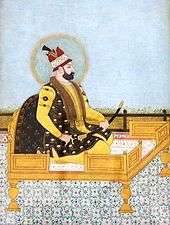
In the spring of 1735, Nader attacked Persia's archrival the Ottomans and regained most of the territory lost during the recent chaos. At the same time, the Abdali Afghans rebelled and besieged Mashhad, forcing Nader to suspend his campaign and save his brother, Ebrahim. It took Nader fourteen months to crush this uprising.
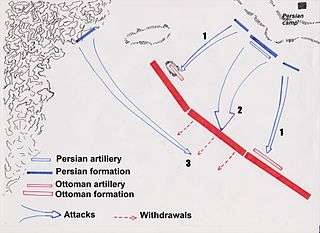
Relations between Nader and the Shah had declined as the latter grew jealous of his general's military successes. While Nader was absent in the east, Tahmasp tried to assert himself by launching a foolhardy campaign to recapture Yerevan. He ended up losing all of Nader's recent gains to the Ottomans, and signed a treaty ceding Georgia and Armenia in exchange for Tabriz. Nader, furious, saw that the moment had come to ease Tahmasp from power. He denounced the treaty, seeking popular support for a war against the Ottomans. In Isfahan, Nader got Tahmasp drunk then showed him to the courtiers asking if a man in such a state was fit to rule. In 1732 he forced Tahmasp to abdicate in favour of the Shah's baby son, Abbas III, to whom Nader became regent.
Nader decided, as he continued the 1730–35 war, that he could win back the territory in Armenia and Georgia by seizing Ottoman Baghdad and then offering it in exchange for the lost provinces, but his plan went badly amiss when his army was routed by the Ottoman general Topal Osman Pasha near the city in 1733. Nader decided he needed to regain the initiative as soon as possible to save his position because revolts were already breaking out in Persia. He faced Topal again with a larger force and defeated and killed him. He then besieged Baghdad, as well as Ganja in the northern provinces, earning a Russian alliance against the Ottomans. Nader scored a great victory over a superior Ottoman force at Yeghevard (modern-day Armenia) and by the summer of 1735, Persian Armenia and Georgia were his again. In March 1735, he signed a treaty with the Russians in Ganja by which the latter agreed to withdraw all of their troops from Persian territory,[18][19] those which had not been ceded back by the 1732 Treaty of Resht yet, mainly regarding Derbent, Baku, Tarki, and the surrounding lands, resulting in the reestablishment of Iranian rule over all of the Caucasus and northern mainland Iran again.
Nader becomes king
Nader suggested to his closest intimates, after a great hunting party on the Moghan plains (presently split between Azerbaijan and Iran), that he should be proclaimed the new king (shah) in place of the young Abbas III.[20] The small group of close intimates, Nader's friends, included Tahmasp Khan Jalayer and Hasan-Ali Beg Bestami.[20] Following Nader's suggestion, the group did not "demur", and Hasan-Ali remained silent.[20] When Nader asked him why he remained silent, Hasan-Ali replied that the best thing for Nader to do would be assembling all leading men of the state, in order to receive their agreement in "a signed and sealed document of consent".[20] Nader approved with the proposal, and the writers of the chancellery, which included the court historian Mirza Mehdi Khan Astarabadi, were instructed with sending out orders to the military, religious and nobility of the nation to summon at the plains.[20] The summonses for the people to attend had gone out in November 1735, and they began arriving in January 1736.[21] In the same month of January 1736, Nader held a qoroltai (a grand meeting in the tradition of Genghis Khan and Timur) on the Moghan plains. The Moghan plain was specifically chosen for its size and "abundance of fodder".[22] Everyone agreed to the proposal of Nader becoming the new king, many—if not most—enthusiastically, the rest fearing Nader's anger if they showed support for the deposed Safavids. Nader was crowned Shah of Iran on March 8, 1736, a date his astrologers had chosen as being especially propitious,[23] in attendance of an "exceptionally large assembly" composed of the military, religious and nobility of the nation, as well as the Ottoman ambassador Ali Pasha.[24]
Invasion of the Mughal Empire
- Copied content from Nader Shah article; see that article's history for attribution


In 1738, Nader Shah conquered Kandahar, the last outpost of the Hotaki dynasty. His thoughts now turned to the Mughal Empire based in Delhi. This once powerful Muslim state to the east was falling apart as the nobles became increasingly disobedient and the Hindu Marathas of the Maratha Empire made inroads on its territory from the south-west. Its ruler Muhammad Shah was powerless to reverse this disintegration. Nader asked for the Afghan rebels to be handed over, but the Mughal emperor refused. Nader used the pretext of his Afghan enemies taking refuge in India to cross the border and invade the militarily weak but still extremely wealthy far eastern empire,[25] and in a brilliant campaign against the governor of Peshawar he took a small contingent of his forces on a daunting flank march through nearly impassable mountain passes and took the enemy forces positioned at the mouth of the Khyber Pass completely by surprise, utterly beating them despite being outnumbered two-to-one. This led to the capture Ghazni, Kabul, Peshawar, Sindh and Lahore. As he moved into the Mughal territories, he was loyally accompanied by his Georgian subject and future king of Georgia, Erekle II, who led a Georgian contingent as a military commander as part of Nader's force.[26] Following the defeat of Mughal forces priorly, he then advanced deeper into India crossing the river Indus before the end of year. The news of the Persian army's swift and decisive successes against the northern vassal states of the Mughal empire caused much consternation in Delhi, prompting the Mughal ruler, Muhammad Shah, to summon an overwhelming force of some 300,000 men and march this gigantic host north towards the Persian army.
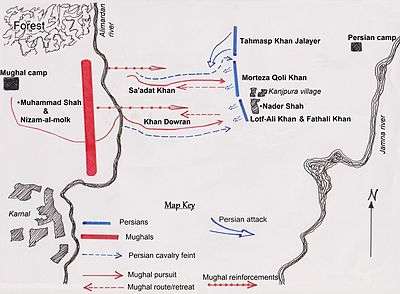
Nader Shah crushed the Mughal army in less than three hours at the huge Battle of Karnal on 13 February 1739. After this spectacular victory, Nader captured Mohammad Shah and entered with him into Delhi.[27] When a rumour broke out that Nader had been assassinated, some of the Indians attacked and killed Persian troops. Nader, furious, reacted by ordering his soldiers to plunder and sack the city. During the course of one day (March 22) 20,000 to 30,000 Indians were killed by the Persian troops, forcing Mohammad Shah to beg Nader for mercy.[28]
In response, Nader Shah agreed to withdraw, but Mohammad Shah paid the consequence in handing over the keys of his royal treasury, and losing even the Peacock Throne to the Persian emperor. The Peacock Throne thereafter served as a symbol of Persian imperial might. It is estimated that Nadir took away with him treasures worth as much as seven hundred million rupees. Among a trove of other fabulous jewels, Nader also gained the Koh-i-Noor and Darya-ye Noor diamonds (Koh-i-Noor means "Mountain of Light" in Persian, Darya-ye Noor means "Sea of Light"). The Persian troops left Delhi at the beginning of May 1739, but before they left, he ceded back all territories to the east of the Indus which he had overrun to Muhammad Shah.[29] Nader's soldiers also took with them thousands of elephants, horses and camels, loaded with the booty they had collected. The plunder seized from India was so rich that Nader stopped taxation in Iran for a period of three years following his return.[30] Nader attacked the empire to, perhaps, give his country some breathing space after previous turmoils. His successful campaign and replenishment of funds meant that he could continue his wars against Iran's archrival and neighbour, the Ottoman Empire.[31]
The North Caucasus, Central Asia, Arabia, and the second Ottoman war
The Indian campaign was the zenith of Nader's career. After his return from India, Nader fell out with his eldest son Reza Qoli Mirza, who had ruled Persia during his father's absence. Having heard a rumour that Nader was dead, he had prepared to seize the throne by having the Safavid royal captives, Tahmasp and his son Abbas, executed. Nader was not pleased with the young man's behaviour and humiliated him by removing him from the post of viceroy. Nader became increasingly despotic as his health declined markedly. Nader had left his son Reza Qoli Mirza to rule Persia in his absence. Reza had behaved highhandedly and somewhat cruelly but he had kept the peace in Persia. Having heard rumours that his father had died, he had made preparations for assuming the crown. These included the murder of the former shah Tahmasp and his family, including the nine-year-old Abbas III. On hearing the news, Reza's wife, who was Tahmasp's sister, committed suicide. Nader was not impressed with his son's waywardness and reprimanded him, but he took him on his expedition to conquer territory in Transoxiana. In 1740 he conquered Khanate of Khiva. After the Persians had forced the Uzbek khanate of Bokhara to submit, Nader wanted Reza to marry the khan's elder daughter because she was a descendant of his hero Genghis Khan, but Reza flatly refused and Nader married the girl himself. Nader also conquered Khwarezm on this expedition into Central Asia.[32]

Nader now decided to punish Daghestan for the death of his brother Ebrahim Qoli on a campaign a few years earlier. In 1741, while Nader was passing through the forest of Mazanderan on his way to fight the Daghestanis, an assassin took a shot at him but Nader was only lightly wounded. He began to suspect his son was behind the attempt and confined him to Tehran. Nader's increasing ill health made his temper ever worse. Perhaps it was his illness that made Nader lose the initiative in his war against the Lezgin tribes of Daghestan. Frustratingly for him, they resorted to guerrilla warfare and the Persians could make little headway against them.[33] Though Nader managed to take most of Dagestan during his campaign, the effective guerrilla warfare as deployed by the Lezgins, but also the Avars and Laks made the Iranian re-conquest of the particular North Caucasian region this time a short lived one; several years later, Nader was forced to withdraw. During the same period, Nader accused his son of being behind the assassination attempt in Mazanderan. Reza angrily protested his innocence, but Nader had him blinded as punishment, although he immediately regretted it. Soon afterwards, Nader started executing the nobles who had witnessed his son's blinding. In his last years, Nader became increasingly paranoid, ordering the assassination of large numbers of suspected enemies.
With the wealth he gained, Nader started to build a Persian navy. With lumber from Mazandaran, he built ships in Bushehr. He also purchased thirty ships in India.[17] He recaptured the island of Bahrain from the Arabs. In 1743, he conquered Oman and its main capital Muscat. In 1743, Nader started another war against the Ottoman Empire. Despite having a huge army at his disposal, in this campaign Nader showed little of his former military brilliance. It ended in 1746 with the signing of a peace treaty, in which the Ottomans agreed to let Nader occupy Najaf.[34]
Afsharid Military
See Military of the Afsharid dynasty of Persia.
Religious Policy
- Copied content from Nader Shah article; see that article's history for attribution
The Safavids had introduced Shi'a Islam as the state religion of Iran. Nader was probably brought up as a Shi'a [35] but later espoused the Sunni[36] faith as he gained power and began to push into the Ottoman Empire. He believed that Safavid Shi'ism had intensified the conflict with the Sunni Ottoman Empire. His army was a mix of Shi'a and Sunni (with a notable minority of Christians) and included his own Qizilbash as well as Uzbeks, Afghans, Christian Georgians and Armenians,[37][38] and others. He wanted Persia to adopt a form of religion that would be more acceptable to Sunnis and suggested that Persia adopt a form of Shi'ism he called "Ja'fari", in honour of the sixth Shi'a imam Ja'far al-Sadiq. He banned certain Shi'a practices which were particularly offensive to Sunnis, such as the cursing of the first three caliphs. Personally, Nader is said to have been indifferent towards religion and the French Jesuit who served as his personal physician reported that it was difficult to know which religion he followed and that many who knew him best said that he had none.[39] Nader hoped that "Ja'farism" would be accepted as a fifth school (mazhab) of Sunni Islam and that the Ottomans would allow its adherents to go on the hajj, or pilgrimage, to Mecca, which was within their territory. In the subsequent peace negotiations, the Ottomans refused to acknowledge Ja'farism as a fifth mazhab but they did allow Persian pilgrims to go on the hajj. Nader was interested in gaining rights for Persians to go on the hajj in part because of revenues from the pilgrimage trade.[17] Nader's other primary aim in his religious reforms was to weaken the Safavids further since Shi'a Islam had always been a major element in support for the dynasty. He had the chief mullah of Persia strangled after he was heard expressing support for the Safavids. Among his reforms was the introduction of what came to be known as the kolah-e Naderi. This was a hat with four peaks which symbolised the first four caliphs.
Civil war and downfall of the Afsharids
After Nader's death, his nephew Ali Qoli (who may have been involved in the assassination plot) seized the throne and proclaimed himself Adil Shah ("The Just King"). He ordered the execution of all Nader's sons and grandsons, with the exception of the 13-year-old Shahrokh, the son of Reza Qoli.[41] Meanwhile, Nadir's former treasurer, Ahmad Shah Abdali, had declared his independence by founding the Durrani Empire in Khorasan. In the process, the eastern territories were lost and in the following decades became part of Afghanistan, the successor-state to the Durrani Empire. The northern territories, Iran's most integral regions, had a different fate. In 1747, Erekle II, who had been appointed king of Kakheti by Nader himself several years prior for his loyal service,[42] declared independence and took control of neighbouring Kartli as well; he would unify both several years later in the Kingdom of Kartli-Kakheti, and become the new Georgian king of a politically united eastern Georgia for the first time in three centuries.[43] Under the successive Qajar dynasty, Iran managed to restore Iranian suzerainty over the Georgian regions, until they would be irrevocably lost in the course of the 19th century, to neighbouring Imperial Russia.[44] Many of the rest of the territories in the Caucasus, comprising modern-day Azerbaijan, Armenia, and Dagestan were taken over by local lords, who, until the advent of the Zands and Qajars, many of them often had semi-independent or quasi-independent self-rule, but stayed vassals and subjects to the Iranian king.[45] Under the early Qajars, these territories in Transcaucasia and Dagestan would all be fully reincorporated into Iran, but eventually permanently lost as well (alongside Georgia), in the course of the 19th century to Imperial Russia through the two Russo-Persian Wars of the 19th century.[44]
Adil made the mistake of sending his brother Ebrahim to secure the capital Isfahan. Ebrahim decided to set himself up as a rival, defeated Adil in battle, blinded him and took the throne. Adil had reigned for less than a year. Meanwhile, a group of army officers freed Shahrokh from prison in Mashhad and proclaimed him shah in October 1748. Ebrahim was defeated and died in captivity in 1750 and Adil was also put to death at the request of Nader Shah's widow. Shahrokh was briefly deposed in favour of another puppet ruler Soleyman II but, although blinded, Shahrokh was restored to the throne by his supporters. He reigned in Mashhad and from the 1750s his territory was mostly confined to Khorasan. In 1796 Mohammad Khan Qajar, the founder of the Qajar dynasty, seized Mashhad and tortured Shahrokh to force him to reveal the whereabouts of Nader Shah's treasures. Shahrokh died of his injuries soon after and with him the Afsharid dynasty came to an end.[39][46] Shahrokh's descendants continue into the 21st century under the Afshar Naderi surname.
List of Afsharid monarchs
- Nader Shah (1736–1747)
- Adil Shah (1747–1748)
- Ebrahim Afshar (1748)
- Shahrukh Afshar (1748–1796)
Family tree
| Imam Qoli (d. 1704) | |||||||||||||||||||||||||||
| Ebrahim Khan (d. 1738) | Nader Shah (r. 1736–1747)1 | ||||||||||||||||||||||||||
| Adil Shah (r. 1747–1748)2 | Ebrahim Afshar (r. 1748)3 | Reza Qoli Mirza (b. 1719 – d.1747) | |||||||||||||||||||||||||
| Shahrukh Afshar (r. 1748–1796)4 | |||||||||||||||||||||||||||
| Nader Mirza (d. 1803) | |||||||||||||||||||||||||||
See also
References
- ↑ "NĀDER SHAH – Encyclopaedia Iranica".
- ↑ Soucek, Svat (2000). A History of Inner Asia. Cambridge University Press. p. 179. ISBN 9780521657044.
In 1740 Nadir Shah, the new ruler of Iran, crossed the Amu Darya and, accepting the submission of Muhammad Hakim Bi which was then formalized by the acquiescence of Abulfayz Khan himself, proceeded to attack Khiva. When rebellions broke out in 1743 upon the death of Muhammad Hakim, the shah dispatched the ataliq's son Muhammad Rahim Bi, who had accompanied him to Iran, to quell them.
- ↑ Katouzian, Homa (2003). Iranian History and Politics. Routledge. p. 128. ISBN 0-415-29754-0.
Indeed, since the formation of the Ghaznavids state in the tenth century until the fall of Qajars at the beginning of the twentieth century, most parts of the Iranian cultural regions were ruled by Turkic-speaking dynasties most of the time. At the same time, the official language was Persian, the court literature was in Persian, and most of the chancellors, ministers, and mandarins were Persian speakers of the highest learning and ability.
- ↑ "HISTORIOGRAPHY vii. AFSHARID AND ZAND PERIODS – Encyclopaedia Iranica".
Afsharid and Zand court histories largely followed Safavid models in their structure and language, but departed from long-established historiographical conventions in small but meaningful ways.
- ↑ Axworthy, Michael (2006). The Sword of Persia. I.B. Tauris. pp. 5, 45, 70, 80, 157, 279. ISBN 1-84511-982-7.
- ↑ علیاصغر شمیم، ایران در دوره سلطنت قاجار، تهران: انتشارات علمی، ۱۳۷۱، ص ۲۸۷
- ↑ Michael Axworthy's biography of Nader, The Sword of Persia (I.B. Tauris, 2006), pp. 17–19: "His father was of lowly but respectable status, a herdsman of the Afshar tribe ... The Qereqlu Afshars to whom Nader's father belonged were a semi-nomadic Turcoman tribe settled in Khorasan in north-eastern Iran ... The tribes of Khorasan were for the most part ethnically distinct from the Persian-speaking population, speaking Turkic or Kurdish languages. Nader's mother tongue was a dialect of the language group spoken by the Turkic tribes of Iran and Central Asia, and he would have quickly learned Persian, the language of high culture and the cities as he grew older. But the Turkic language was always his preferred everyday speech, unless he was dealing with someone who knew only Persian."
- ↑ Cambridge History of Iran Volume 7, pp. 2–4
- ↑ Encyclopedia Iranica
- ↑ Martin, Samuel Elmo (1997). Uralic And Altaic Series. Routledge. p. 47. ISBN 0-7007-0380-2.
- ↑ Michael Axworthy Iran: Empire of the Mind (Penguin, 2008) pp.153–156
- ↑ "Russia at War: From the Mongol Conquest to Afghanistan, Chechnya, and Beyond ...". Retrieved 25 December 2014.
- ↑ Tucker, Ernest (2006). "Nāder Shah". Encyclopædia Iranica Online. Retrieved 5 January 2014.
- ↑
- ↑ Axworthy pp. 57–74
- ↑ Axworthy pp. 75–116
- 1 2 3 Encyclopedia Iranica
- ↑ Elton L. Daniel, "The History of Iran" (Greenwood Press 2000) p. 94
- ↑ Lawrence Lockhart Nadir Shah (London, 1938)
- 1 2 3 4 5 Fisher et al. 1991, pp. 34.
- ↑ Fisher et al. 1991, pp. 36.
- ↑ Fisher et al. 1991, pp. 35.
- ↑ This section: Axworthy pp.137-174
- ↑ Fisher et al. 1991, pp. 34-36.
- ↑ Raghunath Rai. "History". p. 19 FK Publications ISBN 8187139692
- ↑ David Marshall Lang. Russia and the Armenians of Transcaucasia, 1797-1889: a documentary record Columbia University Press, 1957 (digitalised March 2009, originally from the University of Michigan) p 142
- ↑ "An Outline of the History of Persia During the Last Two Centuries (A.D. 1722-1922)". Edward G. Browne. London: Packard Humanities Institute. p. 33. Retrieved 2010-09-24.
- ↑ Axworthy p. 8
- ↑ Axworthy, Michael (2010). Sword of Persia: Nader Shah, from Tribal Warrior to Conquering Tyrant. I.B. Tauris. pp. 212, 216. ISBN 978-0857733474.
- ↑ This section: Axworthy pp.1–16, 175–210
- ↑ The Sword of Persia: Nader Shah, from Tribal Warrior to Conquering Tyrant. Retrieved 8 March 2015.
- ↑ svat soucek, a history of inner asia page 195: in 1740 Nadir Shah, the new ruler of Iran, crossed the Amu Darya and, accepting the submission of Muhammad Hakim Bi which was then formalized by the acquiescence of Abulfayz Khan himself, proceeded to attack Khiva. When rebellions broke out in 1743 upon the death of Muhammad Hakim, the shah dispatched the ataliq's son Muhammad Rahim Bi, who had accompanied him to Iran, to quell them. Mohammad hakim bi was ruler of the khanate of bukhara at that time. Page link: http://librarun.org/book/63545/195
- ↑ Spencer C. Tucker. "A Global Chronology of Conflict: From the Ancient World to the Modern Middle East: From the Ancient World to the Modern Middle East" p 739
- ↑ This section: Axworthy pp. 175–274
- ↑ Axworthy p.34
- ↑ Mattair, Thomas R. (2008). Global security watch--Iran: a reference handbook. ABC-CLIO. p. 3. ISBN 9780275994839. Retrieved 2010-09-24.
- ↑ "The Army of Nader Shah" (PDF). Retrieved 17 December 2014.
- ↑ Steven R. Ward. Immortal, Updated Edition: A Military History of Iran and Its Armed Forces Georgetown University Press, 8 jan. 2014 p 52
- 1 2 Axworthy p.168
- ↑ Perry, Jonothan R. Karim Khan Zand. N.p.: Oneworld, 2006. Ebook, retrieved July 6, 2016. ISBN 1851684352
- ↑ Cambridge History p.59
- ↑ Ronald Grigor Suny. "The Making of the Georgian Nation" Indiana University Press, 1994. ISBN 978-0253209153 p 55
- ↑ Yar-Shater, Ehsan. Encyclopaedia Iranica, Vol. 8, parts 4-6 Routledge & Kegan Paul (original from the University of Michigan) p 541
- 1 2 Timothy C. Dowling Russia at War: From the Mongol Conquest to Afghanistan, Chechnya, and Beyond p 728-729 ABC-CLIO, 2 dec. 2014 ISBN 1598849484
- ↑ Encyclopedia of Soviet law By Ferdinand Joseph Maria Feldbrugge, Gerard Pieter van den Berg, William B. Simons, Page 457
- ↑ Cambridge History pp.60–62
Sources
- Michael Axworthy, The Sword of Persia: Nader Shah, from Tribal Warrior to Conquering Tyrant Hardcover 348 pages (26 July 2006) Publisher: I.B. Tauris Language: English ISBN 1-85043-706-8
- Fisher, William Bayne; Avery, P.; Hambly, G. R. G; Melville, C. (1991). The Cambridge History of Iran. 7. Cambridge: Cambridge University Press. ISBN 0521200954.
External links
| Wikimedia Commons has media related to Afsharid dynasty. |
- "Afsharids", Encyclopedia Iranica (mostly about Asharids after Nader Shah)
.svg.png)
